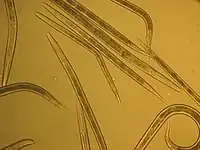Panagrellus redivivus
The free-living nematode Panagrellus redivivus (sour paste nematode,[2] or beer mat nematode from its occurrence in constantly moist felt beer mats),[1] is known to many aquarium enthusiasts and fish keepers as the micro-worm. It is a tiny roundworm used as the first food for larger kinds of newly-hatched fish, such as larval common carp.[3] The microworm is widely used in aquaculture as food for a variety of fish and crustacean species.
| Panagrellus redivivus | |
|---|---|
 | |
| Observation of Panagrellus redivivus on a Zeiss microscope stage | |
| Scientific classification | |
| Kingdom: | |
| Phylum: | |
| Class: | |
| Order: | |
| Family: | Panagrolaimidae |
| Genus: | Panagrellus |
| Species: | P. redivivus |
| Binomial name | |
| Panagrellus redivivus (Linnaeus, 1767) | |
| Synonyms[1] | |
| |
One of thirteen currently recognized species of Panagrellus, P. redivivus is about 50 μm in diameter and just over 1 mm in length, barely visible to the naked eye. Subsisting on yeast, it is easily cultured at home on a substrate of flour paste[4] or porridge inoculated with dry yeast.[5] Females reach maturity in about three days and deliver live young rather than eggs, as most nematodes produce.
The microworm has been used in genetic analysis studies, but not nearly as universally as its relative, Caenorhabditis elegans.
In Vietnamese cuisine, using lactic fermented by yeast rice (cơm mẻ), which contains microworm (con mẻ), to make the sourness of dishes is common.[6]
References
- Ferris H. (2009). "The beer mat nematode, Panagrellus redivivus: A study of the connectedness of scientific discovery" (PDF). J. Nematode Morphol. Syst. 12 (1): 19–25.
- Stock, S., and Nadler, N. 2006. "Morphological and molecular characterization of Panagrellus spp. (Cephalobina: Panagrolaimidae): taxonomic status and phylogenetic relationships". Nematology, 8(6), 921-938.
- Schlechtriem, C., M. Ricci, U. Focken and K. Becker (2004). "The suitability of the free-living nematode Panagrellus redivivus as live food for first-feeding fish larvae". Journal of Applied Ichthyology. 20 (3): 161. doi:10.1111/j.1439-0426.2004.00542.x.CS1 maint: uses authors parameter (link)
- Linnaeus identified the species in library or book paste.
- Worm Culture Information
- (in Vietnamese)"Cơm mẻ - Vị chua từ những chắt chiu". 2020-05-16.
Further reading
- Kovaleva, E.S.; et al. (2003). "Panagrellus redivivus as a molecular model for cyst nematodes". Journal of Nematology. 35 (3): 348.
- Sautter J., Kaiser H., Focken U., Becker K. (2007). "Panagrellus redivivus (Linné) as a live food organism in the early rearing of the catfish Synodontis petricola (Matthes)". Aquaculture Research. 38 (6): 653–659. doi:10.1111/j.1365-2109.2007.01714.x.CS1 maint: uses authors parameter (link)
- Batchelder, E., "Panagrellus redivivus" at Unity College Nematodes